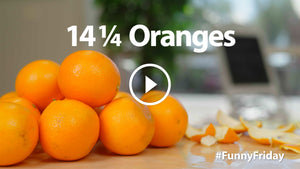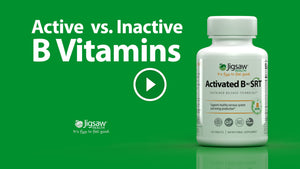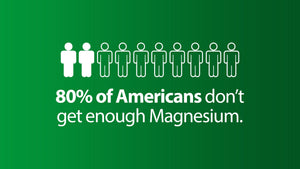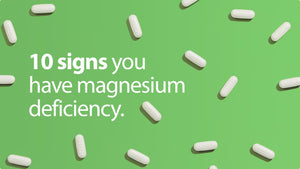The Mitochondria is the powerhouse of the cell. But how do these powerhouses work?
Thomas DeLauer breaks down how our cells utilize fats, carbs, and proteins for energy and how ketosis affects this energy producing process on the latest #ScienceSaturday
Make sure your body is getting the most out of your minerals with MagSRT™ – America's #1 Time-Release Magnesium Supplement:
Click here to add 3 bottles of Jigsaw MagSRT™ to your cart and save $20.94 + $10 off.
Transcript by Rev.com
- What's happening, Jigsaw crew? It's Thomas DeLauer, and it's time to learn about energy. Time to learn about how all your minerals are truly playing a role in energy, but, more importantly, how those carbs, the proteins, and fats that you're consuming are playing a role in how your cells eat them. All right, so let's talk about the mitochondria. Let's talk about the little digestive system inside of our own cells. It is very, very important that you listen to me throughout the entirety of this video. I have to reinforce that. Listen to the entirety of this video, because it is a little bit complex, but I make sure that I break it down in chunks as we go. So if I lose you for a minute, I promise I will come back and make some sense of it. Sometimes the only way my brain works is to be able to explain a complex thing in the complex terminology and then condense it. So I'm doing this in a way that helps me help you. So make sure you're paying attention.
-So I'm gonna take you to the whiteboard, and I'm gonna give you the lowdown. The first thing I'm gonna do is I'm gonna actually break down the structure of the mitochondria, and then I'm gonna go through step-by-step in a very, very, very abbreviated way how the mitochondria works, because it's pretty advanced, but we're gonna really make it simple. All right, so first and foremost, let's take a look at the actual diagram of the mitochondria. So the mitochondria inside of a cell has two different membranes. It has this outer membrane that's right here. Okay, and that outer membrane really just serves as basically the shell, okay. It's protecting it, and it's also allowing different electrons to come in and out and creating this gradient between positively charged electrons and negatively charged electrons. Explain all that in a minute.
-But then what makes the mitochondria extremely unique is this inner membrane, okay. So outer membrane here, inner membrane here. You see how it's all squiggly? The reason that it's squiggly is because it's very, very efficient. The reason that it's efficient is because it has a lot more surface area. See, the body has evolved over such time that they've determined, well, in order to pack more energy into a single cell, we need to combine as much surface area as we possibly can. So it's created this inner membrane that has all these squiggles in it. Surface area is maximized because we have all this surface area. You'll understand in a minute when I start explaining how that inner membrane is so important. But all the energy is created there. That's where the combination of oxygen takes place. That's where everything is actually created.
-So these folds increase that surface area. This, known as the cristae, is basically just the actually characteristic of the squiggles. So the little curves, like here, are called the cristae. They're not really a metabolic function. It's just more a terminology that explains how it's actually structured, okay. Then we have the matrix. The matrix is the fluid that is inside this inner membrane. And inside this matrix, you have water, and you have different proteins, in this case enzymes, that break down and cause different electric charges and non-charges to occur.
-Basically, the mitochondria is all just a balance of the electron transport chain. In short, it's basically a balance of negative and positively charged things going on that are creating energy and creating heat. I'll get to that in just a second too. So let's get down to what it actually is and how this works. What this little, little pea pod kinda thing inside a cell actually is. First of all, it's important that you know that 90% of the energy that we create is created in the mitochondria, whether it's in a brain cell, a liver cell, whatever. They're everywhere. And we have so many of them. They're producing so much energy.
-But it's like a digestive system, okay. Think of it as your cell's digestive system. So we have a digestive system. Whenever we eat things, we start breaking things down, our body extracts the proteins, the fats, the carbs. It does certain things with them. Well, think of this as a second digestive system. It's your cell's stomach and digestive system. That's all it is. Okay, so all of the sugars, the fats, and the proteins that we eat get essentially converted into a truly usable energy here.
-Now, there is a step in between, and I'm not gonna spend a lot of time on that today, because that's a whole different story that you learned your sophomore year of biology class. That's known as the citric acid cycle or the Krebs cycle. And the Krebs cycle, just so that you know, is where we're actually taking these nutrients that we get from food and converting them into pyruvate and acetyl coenzyme A. Okay, so you're gonna hear me talk about pyruvate and acetyl coenzyme A in some other videos too. That's sort of the intermediate step between eating food and it getting converted into something known as ATP.
-Now, I know this is extremely complex, so hear me out. I'm gonna summarize a little bit more too so that everyone is on the same page. The mitochondria is taking the nutrients that we eat, digesting them again to create ATP, adenosine triphosphate. You ever take creatine before? Creatine increases ATP. That's why it helps you get stronger. All we're trying to do here is get from food to energy, ATP, okay. So it all starts with cellular respiration, and that's what we're gonna focus on today, okay. And it all starts with the matrix, which, again, is this liquid portion that's the enzymes and the water. And they end up digesting the pyruvate or the acetyl coenzyme A that is broken down for the sugars, fats, and protein, okay. So they end up breaking it down even more, and then it combines with enzymes in this fluid. And that's where the magic starts to happen. Okay, it actually can break oxygen back down to its total primal state and start breaking all the stuff down into water. The mitochondria is the only place that can take all this energy and all these molecules and just turn 'em into water. It's the only place that that occurs. That's the literally the cellular respiration, as it's called. It's the only place in the body where water is created.
-So, if we actually look at how this works, it's through a process known as oxidative phosphorylation. And what that really is is, again, it's a combination of positively charged ions and negatively charged ions and how they work and how when they have a polarization between the two, they create energy. The simplest way to really put it, I mean, there's a lot of complexity to it, but the simplest way to put it is that we have positively charged exteriors of the mitochondria and negatively charged interiors. Whenever you have what's called a gradient like that, you're creating energy, okay.
-If you've ever taken any chemistry class at all, you might remember the talk about gradients, okay. That is the whole premise of the electron chain. We're moving things along a chain, the electron transport chain. And this gradient of energy from positive to negative creates its own gradient and its own energy, and it's the transfer of electrons. Okay, so that is really what's happening here. But here's what ends up happening. Here's the big process of how that ATP is ultimately created. Okay, the oxygen arrives, the oxygen that we breathe, and it combines with highly, highly, highly charged particles that are a direct result of that Krebs cycle I talked about, okay.
-So, again, the simplest way to put it, the sugar, the stuff we consume, gets turned into something that is known as NADH. Highly, highly, highly charged, very electric. Okay, just think of something like pure electricity here. Okay, this highly charged NADH crosses through and mixes with a negatively charged system in here. That is essentially how energy is created. But let me give you the really cool facts on how it does that. We have here something called ATP synthase, okay. And this ATP synthase is what ends up creating the actual energy. This little thing is a motor. It's a turbine, okay. And these arrows are indicating how it's spinning. So that's just there and it's spinning. Well, here's where it gets cool.
-Remember that electricity from the highly charged NADH that I was talking about? Well, that forces through the membrane. Because we have positive and negatively charged, again, it's this polarization that's sending NADH through this system, causing this to spin even more. So imagine something hitting this, boom, just spinning it, spinning it, spinning it, spinning it. And the more energy that we're creating, the faster that we're creating energy, the more that we're breathing, the more that we're eating, the more that we're working out, we're having more electrically charged things going, moving, moving, moving, spinning this faster and faster and faster and faster. When this spins, it binds ADP with phosphate.
-Okay, you don't have to pay attention to how that really works, but basically that is how we create energy. ATP spins, which causes ADP to combine with phosphate, which creates ATP, which is energy. Again, I'm paraphrasing here, but essentially all it means is that electricity spins this little booger right here and ends up creating energy. This turbine right here is like a motor. It's just the revolutions per minute, just like your car, except it's moving more like 7,000 to 12,000 revolutions per minute. It's moving very, very fast, creating a lot of energy and a lot of heat. And that heat is how you burn fat, my friends.
-So when I start talking about whole mitochondrial efficiency and how ketones and fasting actually end up creating more mitochondrial efficiency, it means this whole system moves easier and faster. Okay, it makes it so that this whole process is smoother, has less resistance, and thereby can create more heat. Now, there's one other thing that mitochondria does that's really cool. It's also a determinator for this cell. In addition to being something that produces energy, it also dictates when a cell dies. Okay, you have a couple of things that go on.
-A cell can die from necrosis, where it just dies, basically an unhealthy death, or it has a genetic predetermined death, apoptosis. This apoptosis is the preprogrammed cell death. But the mitochondria has the ability to tell a cell when to die. It actually is like its own built-in cyanide. It's pretty much that literal. So, we don't wanna piss it off. But basically, here's the general breakdown of how the mitochondria works and how we create energy. Now, I know this is complex. I know this was a lot to swallow. But if you have idea for future videos or further breakdown that you'd like of this, I'm happy to do it. I wanted to keep it high level, because the electron transport chain is not the easiest thing to understand and digest, no pun intended, especially when you're really just calorie-deprived already and you're just trying to get through the day.
-As always, Jigsaw land, you know I'm here to bring you the science. So if you have ideas for future videos, make sure you hit 'em in the comment section below. But as always, you need your minerals so that this process works, so click on the link and check out your MagSRT so you can get your hands on the best magnesium this side of the Mississippi. Well, I guess a lot more than that. See you soon.























